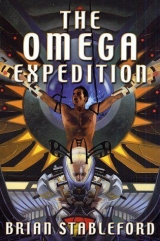
Текст книги "The Omega Expedition"
Автор книги: Brian Stableford
Жанры:
Космическая фантастика
,сообщить о нарушении
Текущая страница: 1 (всего у книги 36 страниц)

Tor Books by Brian Stableford
Inherit the Earth
Architects of Emortality
The Fountains of Youth
The Cassandra Complex
Dark Ararat
The Omega Expedition

This is a work of fiction. All the characters and events portrayed in this novel are either fictitious or are used fictitiously.
THE OMEGA EXPEDITION
Copyright © 2002 by Brian Stableford
All rights reserved, including the right to reproduce this book, or portions thereof, in any form.
Edited by David G. Hartwell
A Tor Book
Published by Tom Doherty Associates, LLC
175 Fifth Avenue
New York, NY 10010
www.tor.com
Tor® is a registered trademark of Tom Doherty Associates, LLC.
ISBN: 0-312-70943-9
For Jane, and all who fully appreciate
the bittersweetness of transience
Contents
Acknowledgments
Introduction
Prologue
One
Two
Three
Four
Five
Being and Time:
Part One
When I Woke Up
One
My Name and Nature
Two
The Wonderful Child
Three
Madoc the Monster
Four
Bad Karma
Five
The Staff of Life
Six
Welcome to the Future
Seven
The Omega Intelligence
Eight
Lilith
Nine
You Can’t go Home Again
Ten
Alchemy and the Afterlife
Eleven
The Politics of Temptation
Twelve
The Temptations of Paranoia
Thirteen
Emortality for All
Fourteen
The Garden of Excelsior
Fifteen
The Ship from Earth
Sixteen
The Men from Earth
Seventeen
The Cyborganizers
Eighteen
Adam Zimmerman’s Awakening
Nineteen
Child of Fortune
Twenty
Invaders from Beyond
Part Two
Worlds In Parallel
Twenty-One
Normal Conditions
Twenty-Two
Injury Time
Twenty-Three
Alice
Twenty-Four
Charity
Twenty-Five
History Lessons
Twenty-Six
Common Cause
Twenty-Seven
Further Possibilities
Twenty-Eight
The Mystery Unravelled
Twenty-Nine
Know Your Enemy
Thirty
Recriminations
Thirty-One
Alice In Wonderland
Thirty-Two
Alice’s Story Continued
Thirty-Three
The Symbolism of Names
Part Three
Babes in the Wilderness
Thirty-Four
An Untrustworthy Interlude
Thirty-Five
A Stray Meditation
Thirty-Six
In the Forest of Confusion
Thirty-Seven
The Palace of La Reine Des Neiges
Thirty-Eight
Of Mirrors and Fragments
Thirty-Nine
Of Moths and Flames
Forty
Opera
Forty-One
Karma
Forty-Two
Inside the Cabal
Forty-Three
Outward Bound
Forty-Four
Adam and the Angels
Forty-Five
Wonderland
Forty-Six
You, Robot
Forty-Seven
A Matter of Life and Death
Forty-Eight
There but for Fortune
Forty-Nine
Madoc Tamlin’s Lostory of Religion
Fifty
Madoc Tamlin’s Apology for the Children of Humankind
Fifty-One
The End of the World
Fifty-Two
Life after Death
Fifty-Three
Weapons of War
Fifty-Four
Rocambole
Fifty-Five
The Final War
Fifty-Six
The Nick of Time
Fifty-Seven
Homecoming
Epilogue
Six
Seven
Eight
Nine
Acknowledgments
A shorter and substantially different version of the narrative framing the text of this novel was published as “And He Not Busy Being Born…” in Interzone16 (1986) and was reprinted in Sexual Chemistry: Sardonic Tales of the Genetic Revolution(Simon & Schuster UK, 1991). That story – the first of many recapitulating and recomplicating the future history sketched out in The Third Millennium: A History of the World, A.D. 2000–3000(Sidgwick & Jackson, 1985; written in collaboration with David Langford) – was the foundation-stone of the series of novels whose sixth and final volume this is, and of the larger enterprise of which that series is a part. I am grateful to David Pringle for its first publication, to various editors who have reprinted it, including Robyn Sisman, Sylvie Denis and James Gunn, and to Damien Broderick for his complimentary remarks on its composition.
I should also like to thank Jane Stableford, my first and best audience; Al Silverstein, for taking an interest; David Hartwell, for seeing the series through to its end; Ian Braid-wood and Nick Gevers, for their altruistic attempts to promote the series; Bill Russell, for his constant support and enthusiasm; and Wolf von Witting, who will approve of the ending for all the wrong reasons.
Introduction
This novel is the final volume in a loosely knit series of six. The other five are all more or less independent, each one carefully constructed as a literary island entire in itself, but this one is different. In order to bring the project to a satisfactory conclusion the major narrative threads running through the series had to be gathered together and integrated into some kind of whole. For that reason, this volume is readable as a direct sequel to any one of four earlier volumes (because it carries forward the stories of characters featured in each of them) and forms a parenthetical pair in association with the other. The purpose of this introduction is to make adequate provision for readers who have not read all – or any – of the earlier volumes in the series, and to enable those who have to refresh their memories.
Volume one of the series, The Cassandra Complex, is set in the year 2041. It tells the story of the belated public revelation of an accidental discovery made by a biologist named Morgan Miller while conducting experiments in the genetic engineering of mice. Miller’s discovery had allowed him to produce a number of mice whose life spans were much greater than those of mice produced by natural selection. Although he had some reason to suppose that a similar genetic transformation might have a similar effect in humans, the process had certain awkward limitations which discouraged him from reporting his findings, even to his closest friends, while he searched for a means to overcome them.
Having grown old without ever solving the problems associated with his life-extending process, Miller had begun to investigate the possibility of handing his results over to an institution capable of carrying on his work. Unfortunately, an imperfect rumor of his long-kept secret had already leaked out, and this move provoked precipitate action by people intent on claiming the rewards of the research for themselves. (I am being deliberately vague here because the novel is framed as a mystery, and I do not want to spoil it for any reader who may want to go on to read it.)
One of the institutions contacted by Miller was the Ahasuerus Foundation, which had been set up some years earlier by a man named Adam Zimmerman to conduct research in technologies of longevity and suspended animation. Zimmerman had been one of the first people to place himself in cryonic suspension before suffering a natural death in the hope that he might one day be revived into a world which had the technological means to keep him alive indefinitely. The continuing work of the Ahasuerus Foundation is a recurrent element in the subsequent books in the series, whose underlying theme is the gradual evolution of a whole series of longevity technologies, each one of which brings humankind a further step closer to “authentic emortality.” Emortality – a term coined by Alvin Silverstein – signifies a state of being in which an organism does not age, and is thus potentially capable of living forever, although it remains permanently vulnerable to death by mortal injury (it is preferable to “immortality” as a specification of the plausible ultimate goal of biotechnology and medical science, because immortality implies an absolute invulnerability to death).
The money that enabled Adam Zimmerman to establish the Ahasuerus Foundation was earned in the service of a powerful consortium of multinational corporations known by a set of more or less derogatory nicknames, including the Secret Masters [of the World] and the Hardinist Cabal. Having benefited from the general tendency of capital to become concentrated in the hands of relatively few very large institutions, and the contrivance of a spectacular stock-market crash in the year 2025, this consortium has become the effective owner of the world. Its members have, however, been careful to provide a philosophical justification for their takeover of the world, in terms of an ideology whose most succinct statement can be found in a classic essay by the economist Garrett Hardin, “The Tragedy of the Commons” (first published in Science162 [1968] pp.1243–8, but reprinted many times) – hence the appellation “Hardinist Cabal.”
Hardin’s argument, in brief, is that when land is made generally available for exploitation – as the commons of ancient England were to owners of livestock – it is in the interests of each and every individual to increase the proportion of his own share, with the ultimate result that overexploitation obliterates the resource. Thus have many fertile areas been turned into desert, just as the world’s oceans are presently being depopulated of fish. Only when a resource is privately owned, and its exploitation carefully constrained, can it be protected from devastation. In my future history, this argument – applied to the Earth as a whole – is used as a justification by the discreet board of directors who have usurped effective ownership of all its resources. The more cynical characters, however, regard the position as a mere pose, suspecting that the new breed of allegedly benevolent dictators are, like all their predecessors, far more interested in dictatorship than benevolence.
Volume two, Inherit the Earth, is set in the year 2193, in a world where the preservative labor of complex sets of nanotechnological devices has extended the attainable human life span to at least 150 years. No one is certain how far this figure might be extended, because its limits cannot be ascertained until the relevant time has actually elapsed, but there is a general optimism that people wealthy enough to have access to the best Internal Technology – IT for short – ought to be able to benefit from an “escalator effect,” whereby each new technological advance will give them sufficient additional life span to be around when the next technological breakthrough arrives, and so on.
An ecocatastrophic Crash, complicated by chaotic “plague wars” in which biological weapons were deployed – mostly by unidentifiable aggressors – had earlier culminated in the advent of a number of new diseases whose result, if not their aim, was the universal sterilization of human females. The response to this crisis, securely in place at the beginning of the novel, was the development of artificial wombs in which egg cells stripped from the wombs of as-yet-uninfected females in very large numbers can be safely isolated, fertilized, and brought to term. The biotechnologists credited with the development of this technology were a closely knit team working under the direction of Conrad Helier.
In the world of the novel, therefore, very few children are reared by their biological parents. Although the right to found a family currently recognized by the United Nations Charter of Human Rights is still cherished, it is almost universally accepted that in a world whose citizens have a reasonable expectation of living for a very long time, the right to found a family ought to be exercised posthumously. The novel’s central character, Damon Hart, is the biological son of Conrad Helier, who was born not long after his father’s death and raised by the surviving members of Helier’s research team. When the novel begins, however, he is estranged from his former foster-parents, having rebelled against the expectations they had of the career path he would take.
The plot of the novel describes events following the kidnapping of one of Damon’s foster parents, apparently by members of a disorganized movement called Eliminators, whose modus operandi is to publish accusations that certain individuals are “unworthy of immortality” and call for their assassination. Among the allegations made on this occasion is the claim that Conrad Helier is still alive, in hiding because he was not only the architect of the solution to the final plague but of the plague itself. Damon sets out to make his own investigation of these allegations with the aid of Madoc Tamlin, a man only slightly older than he, who fancies himself something of an outlaw. Damon had befriended Tamlin during the most extreme phase of his rebellion against his foster parents and the surrounding society, and their friendship has survived the strain exerted upon it by their mutual close acquaintance with the volatile Diana Caisson.
With Tamlin’s aid, and the ambivalent encouragement of interested parties within the Hardinist Cabal, Damon contrives to arrive at the truth of the matter before various rival investigators, who include representatives of the Ahasuerus Foundation as well as the police. He and Tamlin are then faced with awkward decisions regarding the uses to which they might put the information they have gained, and the new career opportunities that have opened up for them.
Another recurrent factor in the series’ future history introduced in this volume is a set of technologies gathered under the nickname “gantzing,” the reference being to a pioneer of biological cementation named Leon Gantz. At this relatively early stage, gantzing microorganisms do little more than stick formerly unpromising materials together in order to make building blocks, but as the series advances gantzing techniques become fundamental to all construction and demolition processes.
Volume three, Dark Ararat, complicates the chronological sequence of the series in being set three years after the arrival of the space Ark Hopein orbit around an “Earth-clone” world in a distant solar system (in 2817, according to the ship’s calendar). Hopehad been built as a response to the ecocatastrophic Crash that occurred between volumes one and two; the Ark had been completed in 2153 and had left the solar system in 2178. The central character of the story, Matthew Fleury, is one of the would-be colonists carried by the Ark in cryonic suspension; from his viewpoint, no time has elapsed since he was frozen down with his two daughters, Michelle and Alice, in 2090.
While the Ark has been en route its crew-members have lived through several generations; during that time they have formed a new view of their mission and destiny that is at odds with the ideas of the Ark’s Hardinist builder, Shen Chin Che – whose claim to own the Ark they fervently dispute. As a result of this difference of opinion the colonization project has gone badly awry. Many of the colonists taken down to the surface of the new world have concluded that the world is not a close enough twin to their homeworld to enable them to flourish there. The genetics of the new world’s ecosphere are peculiar, the native life-forms having cultivated a kind of natural emortality with the aid of a mechanism that echoes Morgan Miller’s ill-fated experiments. Further complications are added to the situation by the knowledge that Earth had not been utterly devastated by the Crash, and that the most recent news from the home planet – which is more than eighty years old – suggests that it is now a burgeoning paradise of near-emortals. (The Ark’s passengers are, of course, mere mortals.)
In the great tradition of Ark-staffing, Matthew was recruited to the human cargo as one member of a pair, in his case of ecological geneticists. He has been revived because his counterpart, Bernal Delgado, has been murdered while investigating the ruins of a city whose unexpected – and rather belated – discovery has added more fuel to the debate about the hospitability of the new world. The humanoid aliens who built the city may well be extinct, but if they are not they must have suffered a social and technological regression so extreme as to have given up on the domestication of fire. The city’s investigators were about to undertake a trip down the nearby river to a peculiar plain, in the hope of clearing up this mystery, when the murder took place. The weapon used to kill Delgado was a crude nonmetallic blade modeled on those once used by the indigenes, but of recent manufacture.
The plot of the novel follows the process of Matthew’s slightly incredulous discovery of Hope’s circumstances, and then describes the expedition from the city to the plain in search of further enlightenment as to the fate of the humanoid aliens. Matthew’s hope that solving the mystery might also allow him to heal the breach between the various rival factions is further emphasized by the knowledge that the future of his two daughters, who are still in suspended animation, depends on the achievement of a healthy and progressive consensus.
It may be relevant at this point to note that although the series was always intended to run to six volumes it was conceived as two sets of three, although this pattern was disrupted by the fact that the books were not contracted for publication – and therefore not issued – in chronological order. The first three books were designed as earnest and relatively orthodox thrillers, whereas the remainder were designed as flamboyant comedies, whose mystery elements would be more obviously contrived.
The reasoning behind this scheme was born of the fear that as the world depicted in the series came gradually closer to a Utopian condition, stories set there would be robbed of most of the dramatic impetus that worlds far from the ideal provide in abundance. Utopian fiction has a notorious tendency to be boring, and the demands of melodrama have been a key factor in determining the preference which science fiction writers have for dealing in more or less horrible futures. My hope was that I could compensate for the melodramatic drain inherent in mapping an improving situation by switching to an alternative narrative currency. For bridging purposes, however, Volume four of the series, Architects of Emortalityretains a calculatedly absurd murder-mystery framework in which a genetic engineer specializing in flower design named Oscar Wilde lends his expertise as an aesthetic theorist to the investigation by UN policepersons Charlotte Holmes and Hal Watson of a series of murders signed (pseudonymously) “Rappaccini.”
By 2495, when Architects of Emortalityis set, the limitations of nanotechnological repair as a technology of longevity, even in combination with periodic rejuvenative somatic engineering treatments, have been conclusively shown up. All recent progress has been made in the field of genetically engineered longevity, which had gone through a long period of relative unfashionability as a result of the seemingly insuperable problem of the Miller Effect – although some further progress was made by courtesy of the continued efforts of such diehard adherents as the Ahasuerus Foundation. Another problematic side effect of longevity has also been publicized, although its existence and effects are dubious: the tendency of long-lived individuals to lose their mental adaptability.
The story told in Architects of Emortalitytakes place at a crucial historical juncture, when the last generation of humans who did not receive the longevity-providing Zaman Transformation at the single-cell stage of their development is approaching the limit of their endurance – the oldest of them routinely attaining a life span of 300 years, but not much more – and the first generation ZT beneficiaries are still young. No one knows, as yet, whether the members of the latest New Human Race are in danger of falling prey to robotization. One of the new breed of genetically enhanced emortals, a junior member of the still-thriving Hardinist Cabal named Michael Lowenthal, attaches himself to the Holmes/Watson investigation as an interested observer. He and Wilde become rivals in their attempts to construct hypothetical motives to rationalize Rappaccini’s murders. Although Wilde proves, in the end, to be the better interpreter, it is Lowenthal who actually reaps a profit – on behalf of his masters – by following the investigation to its astonishing conclusion.
The seemingly final conquest of death that is visible to the characters of Architects of Emortalityis fully realized in volume five of the series, The Fountains of Youth. Unlike its predecessor and the present volume, The Fountains of Youthis a comedy bildungsromanrather than a comedic mystery story; it constitutes the autobiography of Mortimer Gray, a member of the New Human Race born in 2520.
When he writes his autobiography, in 3025, Mortimer still expects to live for several more centuries, if not millennia, but he thinks it worth producing a summary record of the first great project of his life’s work: the compilation of a definitive history of the role formerly played in human affairs by death, issued in ten volumes over a period of four hundred years.
Mortimer Gray’s autobiography records how his determination to write the history of death was actuated by a close encounter of his own, when the cruise ship on which he was taking a holiday was caught up in the Coral Sea Disaster of 2542, when a rift in the Earth’s crust split the ocean bed and spilled out massive amounts of hot magma, causing the sea to boil and sending huge tidal waves to devastate the Pacific Rim. In the aftermath of the disaster Mortimer made the acquaintance of the abruptly orphaned Emily Marchant, whose own determination to make the most of her life was similarly hardened by the misfortune. Emily subsequently becomes very rich, by virtue of extrapolating gantzing techniques to solve the problems of construction in extraterrestrial environments. She is heavily involved in the construction of “ice palaces” on the Jovian and Saturnian satellites – edifices which find an earthbound echo in showpieces constructed in Antarctica, where Mortimer resides while researching the middle part of his project.
Being somewhat accident-prone by the standards of his day, Mortimer has several other close encounters with his subject matter during the compilation of his masterpiece, one of which is consequent on his troubled relationship with the Thanaticists, a briefly fashionable cult interested in the aesthetics of death and disease. The last of these near misses results from a fall through the Arctic ice cap while traveling in a snowmobile. The long discussion about life’s prospects he once shared with Emily Marchant is eerily echoed in a similarly extended and equally intense discussion about death’s significance that he shares with the snowmobile’s navigator: a moderately sophisticated silver. (Over the centuries, Artificial Intelligences have been routinely subcategorized as “sloths” and “silvers”; the acronym AI has been redefined to signify “artificial idiot,” and ai is the Tupi name for the three-toed sloth, while more advanced machines have been redesignated “artificial geniuses,” and Ag is the chemical symbol for silver.)
Toward the end of his labor on the history of death Mortimer has some dealings with the Cyborganizers, a new existential avant garde dedicated to the progressive fusion of humans and inorganic technology. Cyborganization is widely accepted as the emergent norm in extraterrestrial communities, with the exception of faber society – fabers are humans genetically engineered for life in low or zero gravity, whose legs are replaced by an extra set of armlike limbs. On Earth, however, cyborganization is a mere fashion rather than a matter of utilitarian necessity, and it is rivaled there by many other philosophies. These include the ecological mysticism of the Gaean Liberationists, and the ambitions of the Type 2 Movement – followers of the twentieth century prophet Freeman Dyson – whose aim is to extrapolate the technologies employed in continental engineering and terraformation to the construction of vast new macrostructures within the solar system.
I apologize for the fact that this torrent of data is a great deal for the interested reader to bear in mind while following the plot of The Omega Expedition, but the future is a big place and one of the few things that we can confidently say is that it will get less like the present the further it goes. If technological and social progress continue – as we must all hope, in spite of our keen Cassandrian awareness of the impending ecocatastrophic Crash – its strangeness will probably increase much faster than my exceedingly modest future history is content to suppose.
One other thing that the reader might care to bear in mind, if it is not asking too much, is that the greatest merit of science fiction as a genre is to demonstrate by its plenitude that the as yet unmade future holds a multitude of possibilities, whose actual outcome will depend on the choices we make in the present day. There are no predictions in this series of novels, or any other work of science fiction that aspires, no matter how feebly, to intellectual seriousness; all anticipations are conditional. The only purpose the series has, beyond that of providing harmless entertainment, is the hope of making a contribution, however minuscule, to the information of the present-day choices that will determine which of the infinite number of possible futures our emortal descendants will eventually inherit and inhabit.








